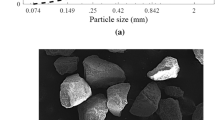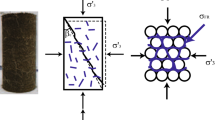Abstract
Among the plethora of studies on anisotropy in fibre-reinforced sands, there exist conflicting views on effects on the steady-state deformations of initial packing. These conflicting views are further confused by strictly limited experimental evidence on flow in complex loading environments where the principal stresses rotate whereby shearing and torsional stresses combine, and when extension in soil relieves the compressive stresses. In the heuristic of intrinsically anisotropic nature of the soil and in recognition of the inability of placement methods to overcome such anisotropy, this paper aims to use the orientation of principal stress and soil initial packing state combined as proxy parameters to further the knowledge of plastic behaviour in fibre-reinforced sands. This study furthers the knowledge of the dependency of steady states on anisotropy in composite geomaterials. In doing so, the direction of principal stress orientation is varied from 15° to 60° (from vertical axis), taking an intermediate principal stress ratio of 0.5 and 1.0 and two initial confining pressures. Twenty-four undrained torsional shear tests are conducted using a hollow cylindrical torsional shear apparatus. Under compression and plain strain conditions, torsional stresses limit the improvements in soils’ undrained shear strength upon fibre reinforcement. Extension in soil remarkably increases fibres’ contribution to betterment of undrained strength. Fibres are least effective under low isotropic confining pressures and also for certain ranges of torsional stresses.












Similar content being viewed by others
References
Ishihara K, Acacio A, Towhata I (1993) Liquefaction-induced ground damage in Dagupan in the July 16, 1990 Luzon earthquake. Soils Found 33(1):133–154
Chian SC, Tokimatsu K, Madabhushi SPG (2014) Soil liquefaction-induced uplift of underground structures: physical and numerical modeling. J Geotech Geoenviron Eng 140(04014057):1–18
Ardeshiri-Lajimi S, Yazdani M, Assadi-Langroudi A (2016) A study on the liquefaction risk in seismic design of foundations. Geomech Eng 11(6):805–820
Sabbar AS, Chegenizadeh A, Nikraz H (2017) Static liquefaction of very loose sand-slag-bentonite mixtures. Soils Found 57:341–356
Yang J, Wei L (2012) Collapse of loose sand with the addition of fines: the role of particle shape. Geotechnique 62(12):1111–1125
Hight DW, Bennell JD, Chana B, Davis PD, Jardine RJ, Porovi E (1997) Wave velocity and stiffness measurements of the Crag and Lower London Tertiaries at Sizewell. Geotechnique 47(3):451–474
Jefferies MG, Been K (2006) Soil liquefaction: a critical state approach. Taylor and Francis, Abingdon
Arthur JRF, Chua KS, Dunstan T, Rodriguez CJI (1980) Principal stress rotation: a missing parameter. J Geotech Eng Div ASCE 106(4):419–433
Waldron LJ (1977) The shear resistance of root-permeated homogeneous and stratified soil. Soil Sci Soc Am J 41(5):843–849
Gray DH, Ohashi H (1983) Mechanics of fiber reinforcement in sand. J Geotech Eng ASCE 109:335–353
Maher MH, Gray DH (1990) Static response of sands reinforced with randomly distributed fibers. J Geotech Eng ASCE 116(11):1661–1677
Michalowski RL, Zhao A (1996) Failure of fiber-reinforced granular soils. J Geotech Eng ASCE 122(3):226–234
Michalowski RL, Cermák J (2003) Triaxial compression of sand reinforced with fibers. J Geotech Geoenviron Eng ASCE 129(2):125–136
Michalowski RL (2008) Limit analysis with anisotropic fibre-reinforced soil. Geotechnique 58(6):489–501
Diambra A, Russell AR, Ibraim E, Wood DM (2007) Determination of fibre orientation distribution in reinforced sands. Geotechnique 57(7):623–628
Ibraim E, Diambra A, Russell AR, Wood DM (2012) Assessment of laboratory sample preparation for fibre reinforced sands. Geotext Geomembr 34:69–79
Jewell RA, Wroth CP (1987) Direct shear tests on reinforced sand. Geotechnique 37(1):53–68
Palmeira EM, Milligan WE (1989) Scale and other factors affecting the results of pull-out tests of grids buried in sand. Geotechnique 39:511–524
Symes MJ (1983) Rotation of principal stresses in sand. Imperial College of Science, London
Sayão A, Vaid Y (1996) Effect of intermediate principal stress on the deformation response of sand. Can Geotech J 33:822–828
Li C (2005) Mechanical response of fiber-reinforced soil. The University of Texas at Austin, Austin
Diambra A, Ibraim E, Wood DM, Russell AR (2010) Fibre reinforced sands: experiments and modelling. Geotext Geomembr 28(3):238–250
Mandolini A, Diambra A, Ibraim E (2019) Strength anisotropy of fibre reinforced sands under multiaxial loading. Geotechnique 69(3):203–216
Shibuya S (1985) Undrained behaviour of granular materials under principal stress rotation. Imperial College of Science, London
Menkiti CO (1995) Behaviour of clay and clayey-sand, with particular reference to principal stress rotation. Imperial College of Science, London
Zdravkovic L (1996) The stress-strain-strength anisotropy of a granular medium under general stress conditions. Imperial College of Science, London
Porovic E (1995) Investigations of soil behaviour using a resonant column torsional shear hollow cylinder apparatus. Imperial College of Science, London
Jardine RJ, Menkiti CO (1999) The undrained anisotropy of K0 consolidated sediments. In: Proceedings of the 12th ECSMFE geotechnical engineering for transportation infrastructure, Rotterdam, pp 1101–1108
Jardine RJ, Zdravkovic L, Porovic E (1997) Anisotropic consolidation including principal stress axis rotation: experiments, results and practical implications. In: XIVth ICSMFE, Hamburg, pp 2165–2169
Yoshimine M, Ishihara K, Vargas W (1998) Flow deformation of sands subjected to principal stress rotation. Soils Found 38(3):179–188
Symes MJ, Gens A, Hight DW (1985) Discussion: the development of a new hollow cylinder apparatus for investigating the effects of principal stress rotation in soils undrained anisotropy and principal stress rotation in saturated sand. Géotechnique 35(1):78–85
Nakata Y, Hyodo M, Murata H, Yasufuku N (1998) Flow deformation of sands subjected to principal stress rotation. Soils Found 38(2):115–128
Vaid YP, Sivathayalan S, Uthayakumar M, Eliadorani A (1995) Liquefaction potential of reconstituted Syncrude sand. In: Proceedings of the 48th Canadian geotechnical conference, Vancouver, Canada, pp 319–328
Vaid YP, Uthayakumar M, Sivathayalan S, Robertson PK, Hofman B (1995) Laboratory testing of Syncrude Sand. In: Proceedings of the 48th Canadian geotechnical conference, Vancouver, Canada, pp 223–232
Uthayakumar M, Vaid YP (1998) Static liquefaction of sands under multiaxial loading. Can Geotech J 35:273–283
Diambra A, Ibraim E (2015) Fibre-reinforced sand: interaction at the fibre and grain scale. Géotechnique 64(4):296–308
Shukla SK (2017) Fundamentals of fibre-reinforced soil engineering. Springer, New York
Consoli NC, Casagrande MDT, Coop MR (2005) Effect of fibre reinforcement on the isotropic compression behaviour of a sand. J Geotech Geoenviron Eng 131:1434–1436
Soriano I, Ibraim E, Ando E, Diambra A, Laurencin T, Moro P, Viggiani G (2017) 3D fibre architecture of fibre-reinforced sand. Granul Matter 19(4):75
Mirzababaei M, Arulrajah A, Haque A, Nimbalkar S, Mohajerani A (2018) Effect of fiber reinforcement on shear strength and void ratio of soft clay. Geosynth Int 25(4):471–480
Marri A, Uddin S, Wanatowski D (2014) Sample preparation technique for fibre reinforced cemented soils. Procedia Eng 77:140–147
Ibraim E, Fourmont S (2006) Behaviour of sand reinforced with fibres. In: Ling HI, Callisto L, Leshchinsky D, Koseki J (eds) Proceedings of the geotechnical symposium, geomechanics: laboratory testing, modelling and applications, Rome, Italy, pp 807–818
Lade PV, Ibsen LB (1997) A study of the phase transformation and the characteristic lines of sand behaviour. In: International symposium on deformation and progressive failure in geomechanics, Nagoya, Japan
Robertson PK, Wride CE, List BR, Atukorala U, Biggar KW, Byrne PM, Campanella RG, Cathro DC, Chan DH, Czajewski K, Finn WDL, Gu WH, Hammamji Y, Hofmann BA, Howie JA, Hughes J, Imrie AS, Konrad JM, Kupper A, Law T, Lord ER, Monahan PA, Morgenstern NR, Philips R, Piche R, Plewses HD, Scott D, Sego DC, Sobkowicz J, Stewart RA, Watts BD, Woeller DJ, Youd TL, Zavodni Z (2000) The CANLEX project: summary and conclusions. Can Geotech J 37(3):563–591
Vaid YP, Sivathayalan S (2000) Fundamental factors affecting liquefaction susceptibility of sands. Can Geotech J 37:592–606
Yoshimine M, Ishihara K (1998) Flow potential of sands during liquefaction. Soils Found 38(3):189–198
Yoshimine M, Robertson PK, Wride CE (1999) Undrained shear strength of clean sands to trigger flow liquefaction. Can Geotech J 36:891–906
Shibuya S, Hight DW (1987) Patterns of cyclic principal stress rotation and liquefaction. In: Proceedings of the 8th Asian regional conference on soil mechanics and foundation engineering, Kyoto, Japan, vol 1, pp 265–268
Shibuya S, Hight DW, Jardine RJ (2003) Local boundary surface of a loose sand dependent on consolidation path. Soils Found 43(3):85–93
Poulos SJ (1981) the steady state of deformation. J Geotech Eng ASCE 107:553–562
Poulos SJ, Castro G, France JW (1985) Liquefaction evaluation procedure. J Geotech Eng ASCE 111(6):772–792
ASTM D6913/D6913M-17 (2017) Standard test methods for particle size distribution (gradation) of soils using sieve analysis. ASTM International, West Conshohocken
ASTM D854-14 (2014) Standard test methods for specific gravity of soil solids by water pycnometer. ASTM International, West Conshohocken
ASTM D4254-16 (2016) Standard test methods for minimum index density and unit weight of soils and calculation of relative density. ASTM International, West Conshohocken
ASTM D4253-16 (2016) Standard test methods for maximum index density and unit weight of soils using a vibratory table. ASTM International, West Conshohocken
Author information
Authors and Affiliations
Corresponding author
Additional information
Publisher's Note
Springer Nature remains neutral with regard to jurisdictional claims in published maps and institutional affiliations.
Rights and permissions
About this article
Cite this article
Ghadr, S., Bahadori, H. & Assadi-Langroudi, A. Anisotropy in Sand–Fibre Composites and Undrained Stress–Strain Implications. Int. J. of Geosynth. and Ground Eng. 5, 23 (2019). https://doi.org/10.1007/s40891-019-0174-x
Received:
Accepted:
Published:
DOI: https://doi.org/10.1007/s40891-019-0174-x




